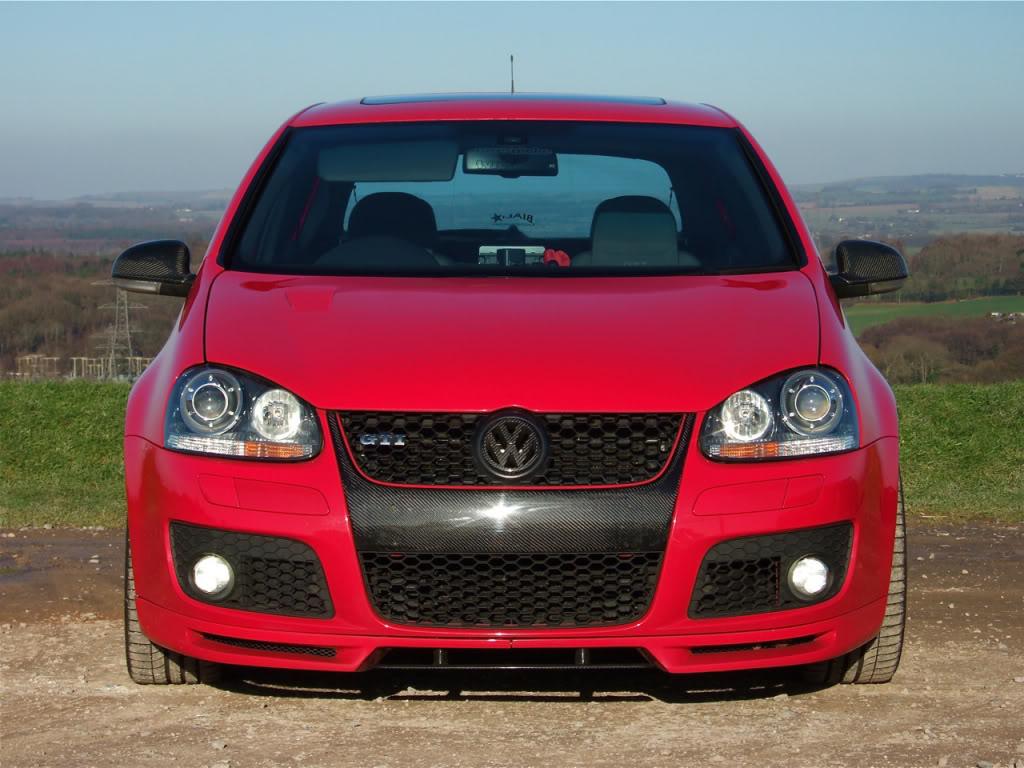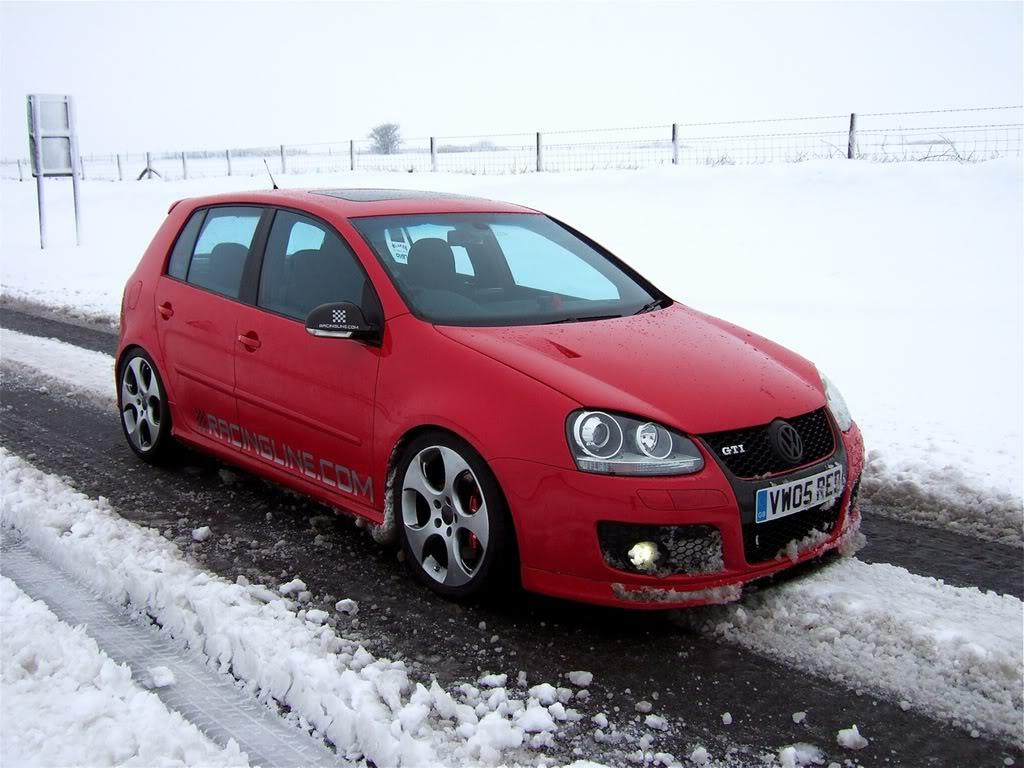....
WHAT IS A SPLITTER?As the front of a car slows down the air without a diffuser, this is the ideal place for an inlet. A splitter is commonly used here, serving to increase the amount of downforce at the front of the car. The airstream is brought to stagnation above the splitter by an air dam, causing an area of high pressure. Below the splitter, the air is redirected away from the stagnation zone and is accelerated, causing the pressure to drop. This, combined with the high pressure over the splitter creates downforce. The larger the area of the splitter, the more downforce is generated. In most closed-wheel race cars, the underside of the splitter smoothly integrates with the undertray, creating one large flat plane that is driven by the rear diffuser. [source: Wikipedia]
However, that is mostly in the context of a race car but inevitably performance road cars can benefit from having a splitter and/or diffusers. Also inevitably, there is an element of fashion which creeps into the equation and some aftermarket splitters can be purely cosmetic.
This is a good example of a race style splitter, also known as a spoiler, on a performance road car:
 WHY BUY ONE?
WHY BUY ONE?Either because you hope to improve aerodynamics and downforce because you believe it will benefit you, probably mostly on track days. Or as a cosmetic improvement which makes your car look more purposeful and aggressive.

^ Before OSIR carbon fog panels were fitted.

^ After OSIR carbon fog panels fitted.
WHY BUY AN OSIR SPLITTER?Probably primarily for cosmetic reasons as I have seen no hard data to support there being any real aerodynamic or downforce advantages. That's not to say that there aren't any advantages but just that any claims are scientifically unproven at this moment in time. But neither have I seen scientific data to prove the effects of other aftermarket splitters for the Mk5 GTI.
It has to be said that cosmetically the OSIR splitter is the least aftermarket (none VW product) in appearance currently on the market for the Mk5 GTI. I say this because the shape and ducts blend with and match perfectly the styling of the ex-factory GTI front. Refer to Audi A4 to RS4 frontal styling differences to see the equivalent. OSIR's aesthetic design has been very well thought out, but that is Riso's strength as a designer. He was involved in some of the Mk5 American Thunderbunny styling exercises for Volkswagen and is well respected.

^ 2-part OSIR without centre section.
The first OSIR splitters were fibreglass but the current V3 is PU plastic, made of the same chip resistant material as the factory bumper. My professional bodyshop tells me that fibreglass is much easier to repair and even I have found I can successfully repair mine.



^ Masking is the key to a good finish. By the way, a solid foam floor pad is invaluable for working comfort.
There are options available for the central splitter section: Two shapes in either carbon or plastic primed for painting.

^ DF-1 centre section.

^ DF-1 centre section not easily visible when fitted.

^ DF-2 centre section. Works as a functional splitter with an open back. Visible.

^ Version 3 PU splitter showing how the OSIR components fit together.

^ April 2012: PU version fitted to my car.
ALTERNATIVES:- OEM Edition30 or Votex style: The splitter is moulded in and so air only feeds under the floor pan as the OEM GTI.
- Volkswagen Racing: Primarily functional. Black plastic but can be painted but will need much chip maintenance if painted.
- Reiger: Looks identical to the VWR but reputed to be less strong. Thoroughly tested and frequently broken by our very own Joe.
- Abt: Very fussy design and deeper than any of the others.
- There are others but mostly over designed and fussy in my opinion.

^ Volkswagen Racing splitter/spoiler.
SOURCING:The TTshop Bedford are OSIR's officially appointed European distributor and give good aftersales support.
Web:
http://www.ttsroadsport.comPhone: 01234 855 555
Price: Liable to fluctuation dependent on currency exchange rates. Nothing from OSIR is cheap.
INSTALLATION:A few screws and some wiggling = Easy. Best done on a ramp or lift for convenience.
PLUS POINTS:- The inlets feed directly in line with the wheel arch openings for brake cooling. Hose ducts could be added if desired if you are a bit of a hardcore trackie.
- Stylish and purposeful in appearance.
- Except to the cognoscente, looks OEM, or at least looks like a factory option and suits the OEM side valances if colour coded.
- Very easy to repair if fibreglass. I don't have experience of plastic repairs - Joe?
 MINUS POINTS:
MINUS POINTS: - If combined with low suspension, road clearance becomes more limited and indoor car park ramps unapproachable.
- The DF-1 centre section will only be visible to baby bunny rabbits in their dying moments. The more visible DF-2 will decapitate them with that slicing leading edge. The blood and guts will at least exit out the back instead of remaining lodged ready for you to clean up. If in carbon, the DF-1 is a waste of money as it is hardly visible - Anyone want to buy mine?
- No scientific proof of aerodynamic performance available. But no proof to back claims from the rival products either.
- Obliges you to consider and probably change the colour, or style, of your side valances.. And then your rear spoiler. Which all adds to the overall expense. It's Slippery Slope time.
- It will not work as a snow plough. In fact it's asking for trouble as I later found out from hard ice pieces.
 SUMMARY:
SUMMARY:I think I am currently the only one on this forum with an OSIR splitter fitted. I don't know what that tells you! There is a school of thought which says that Volkswagen's highly trained and experienced engineers and designers applied considerable time and expertise in evolving the OEM production car and that others should know better than to modify or interfere with the results. However, whereas their efforts should be greatly respected, their production solutions must meet a very wide range of criteria across a number of territories each with their own sets of very strict rules. And then there is production economics and the need for financial profit. The results can only be a degree of compromise and the individual car owner must make up his or her own mind whether to and what to modify.
My decision to modify the front end was essentially for cosmetic reasons initiated by my strong dislike of the OEM Ford Ka-like black plastic rear bumper which looks particularly naff on a red car (in my opinion). My desire to better hear the engine and the consequent purchase of a Milltek exhaust meant a colour coded aftermarket rear needing to accommodate quad pipes. This was done long before the Edition30 was launched, so then meant colour coding the sides, which in turn led to the question of front treatment and my choice of OSIR splitter which I instantly liked. You can see how easy it is to slide down the slippery slope of modifying.
Negotiating speed bumps is very rarely a problem - I just have to go dead slow, like everyone is supposed to, and annoy those following me. But those same people get annoyed when I stick to 30mph in a 30 zone and subsequently wonder what's going on when I suddenly boot it on arrival at the NSL sign, aka the GLF sign (Go Like Feck!) and usually leave them as smalls dots in my rear view mirror. As already said, I don't even bother entering indoor multi-storey car parks. Such compromises are largely due to my low suspension setup but that has been done professionally and delivers awesome handling which gives me great pleasure. It's a trade-off I'm very happy to accept.
I think it's supportable to say that the side inlet slots must improve brake cooling. Any aerodynamic or downforce advantages are incidental if indeed there are any. It would be nice to know of any aero benefits but I am confident no harm is being done and my car is still stable at full maximum speed in the 130-140mph (GPS) range (driven on German unrestricted autobahns).
The bottom line is that I still love the look of my OSIR splitter and the way it's in visual harmony.
